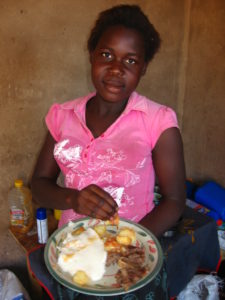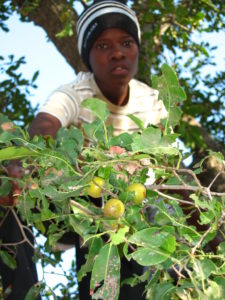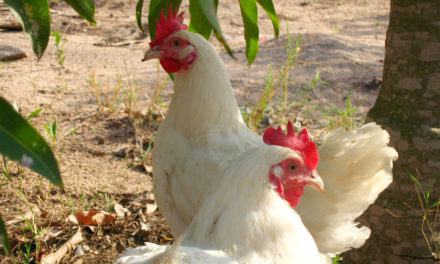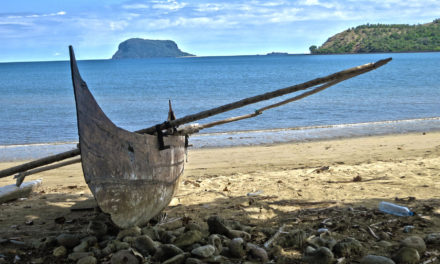I know they say, “You are what you eat.” But if that saying were true, I’d have chicken legs and feet, the body of a locust, my brains would be made out of mopani worms, and my insides would be composed of mushy mealie pap and slimy green leaves and vines. Thankfully that saying isn’t completely true and a person can eat some pretty bizarre things and still remain at least reasonably normal.
I’ve written a lot of serious newsletters lately, so I figured this time would be a little more light-hearted, but no less important to our daily lives and the lives of those around us. Let me tell you about the foods of South Africa, well, especially the foods eaten in and around our village.
All food is usually eaten with your hands, and it’s perfectly acceptable to use both hands. However, most people in the village were under the false assumption that all white people eat alltheir food with a fork and a knife and that we consider it crude if we see them touch their food with their fingers. Thus, when we had a few people over for a pasta dinner one night, we never were able to convince our guests that they didn’t need to cut up their toast with a fork and a knife, even when they saw us eat ours with our hands. Their racial assumptions are so deeply ingrained that they’re sometimes unchangeable, and otherwise they simply need a lot of time to be convinced.
First, no meal here is a meal without “vuswa”, also variously known as “pap” or sometimes just “porridge”. It’s a white creamy-looking substance that resembles mashed potatoes but turns out to be a lot stiffer than that. For a regular meal it’s a small round mountain that usually takes up about 2/3 to 3/4 of the plate. It’s made of a really finely ground maize flour (a rather tasteless variety of corn), which is also called “mealie meal”, and it’s cooked by simply boiling the mealie meal with water and stirring often.
People eat vuswa with pretty much every meal and a slimier variety of it is often cooked for breakfast. To give you an idea of how often and how much is consumed, people often purchase the mealie meal in 70 kg bags (over 150 lbs.) and cart it to their houses by wheelbarrow. Even the women who regularly carry 25 liter buckets of water on their heads for miles have no hope of similarly transporting that much mealie meal.When you eat vuswa, you pull a chunk of it off with your fingers and dip it in the rest of the food. It’s a pretty messy process. It’s often too hot to taste (and definitely burns your fingers), but when it’s had the chance to cool down a bit it usually just tastes like a really bland and mostly flavorless starch. Being mostly flavorless, it’s not that bad, but can get nauseating when you eat too much.
So vuswa is always the staple food, but people also feel that they always have to eat something else with it. The “something else” (“xixevo”) usually takes the form of a “gravy”, and if it’s a regular meal they only prepare one gravy to go with it. But “gravy” is just the word they use to describe any kind of slimy, saucy, soupy stuff, whether it’s made with meat, beans, tomatoes, it doesn’t matter. A pretty standard gravy is made with tomatoes, onions, bell peppers, and water. It’s not too bad really, but since they rarely use spices it also comes off as bland, day after day after day.
South Africa is a very carnivorous country, so everyone feels that they should always eat some kind of meat with their vuswa. The thing is, definitions of “meat” vary from place to place and in my opinion, they use the term very loosely here. The regular meat eaten with vuswa, especially for those on a tight budget (most villagers) is chicken feet, heads, and intestines. Now, I wouldn’t particularly call any of this meat, but since it comes from an animal on land they consider it meat here and it apparently satisfies their cravings pretty well. It’s almost always cooked in the standard gravy of tomatoes, onions, bell peppers, and water.
You can buy a pre-packaged frozen bag of just these parts, but people eat them whether they bought them frozen or killed the chicken themselves. As for the chicken feet, you don’t just chew the rubbery skin off the bones, like you might expect. You’re supposed to pull the claws off the toes, to discard, and then crush the bones and skin and everything together in your teeth, and then swallow. It tastes about like what you’d expect… not much, but fairly unappetizing in thought and texture.
However, everyone here really believes that eating these chicken parts are much superior to eating any combination of vegetables alone. Often, when people find out we’ve had a meal without any meat, they say, “but aren’t you still hungry?”, or simply, “but what about the meat?” And this is from the same people eating the chicken feet, intestines, and heads.
It was formerly my belief that people ate these chicken parts just because they’re cheaper than the more “legitimate” parts, which are also readily available for purchase. However, at special functions where they serve the best food, there’s also often a healthy mix of feet and intestines and everything else thrown in with chicken breasts and chicken legs, etc. I’ve even seen the most honored guests, whether the chief of the village or the head of an organization or whatever, specifically select the feet and intestines along with chicken wings and breasts and everything else. I’ve seen other people select only feet and intestines out of bowls with everything available. So, regardless of how much I dislike those particular “meat” choices, many people legitimately enjoy them here.
Mopani worms are usually boiled for a while first (since they’re usually dried when purchased) and then cooked in the standard gravy. They don’t taste as bad as you might expect when looking at them, but they don’t taste that good either. In my opinion, they have a very earthy flavor, kind of like dirt, no matter what gravy they’re cooked in. And they’re always very chewy too, (Lora describes it as “prickly”) so that each worm could require up to a minute of chewing. That leaves you plenty of time to think about what’s in your mouth and plenty of time to begin feeling nauseous just thinking about it. But all in all the taste isn’t really bad, just not good However, the “xixevo”, or side dish, varies from season to season. Meat (in any form) is always the preference. There’s one season in which dried mopani worms are readily available. They’re not really worms, more like fat caterpillars a few inches long and they actually become very pretty butterflies when allowed to survive. But that doesn’t happen much; mopani worms are intensely enjoyed by nearly everyone here.
Another interesting seasonal “meat” is fried locusts. There’s about two months out of the year when there’s literally hundreds of locusts in everyone’s yard every night and so people go around collecting them to be eaten. Since we obviously don’t know the art of locust catching and cooking, some enterprising neighbors send their kids over from time to time to harvest them in our yard.
It turns out that after people catch the locusts, they pull of their wings and legs so that it’s mainly just their body that’s being eaten. Then they fry them in oil until they’re a bit crispy. And once again, they’re eaten with vuswa, the staple food. I had some of these fried locusts and they honestly weren’t bad at all… reminded me quite a bit of over-barbecued chicken. I wouldn’t mind eating them again sometime, but I still don’t think I’ll be going around harvesting them and cooking them myself.
A few other interesting meat choices are termites and these strange, huge, winged ant-things that come out for just a few days of the year and leave their thousands of wings all over our porch. I haven’t eaten either of these, yet, so I can’t tell you much about them.
One more interesting meat fact: fish isn’t really considered a meat. A lot of people seem to like eating fish from time to time, but I guess because it comes from the water it’s not considered meat.
But as I said, the “xixevo” (side dish) is usually seasonal. So during other parts of the year, especially the middle and end of summer, “miroho” is often eaten. “Miroho” is any kind of leafy green vegetable and everyone seems to have their own particular favorite.
Because miroho includes any kind of leafy green vegetable, some comes from regular leafy plants like we’re used to such as cabbage and “spinach” (which is actually a type of chard), some comes from what looks like weeds that grow wild in people’s yards and in the bush around the village, some comes from vines that grow on fences, and some comes from leaf stalks of much bushier plants.
Though miroho is usually a substitute for meat when eaten at a regular meal, most people seem to enjoy it enough that we don’t hear the common complaints about lack of meat. All miroho is boiled and peanuts are often cooked into it, and less often, onions, tomatoes and/or chili peppers.
The two main crops that people grow, and only during the summer when there’s enough rain, is maize and peanuts. The maize is basically just corn but with harder kernels and not nearly as sweet. The “peanuts” apparently aren’t actually peanuts, but some kind of ground nut that’s mostly like a peanut. So, around the end of summer when it’s time to harvest these, they roast or boil the maize and they boil the peanuts and snack on them throughout the day. Sometimes, if they snack enough, they skip their regular meals and only eat a little vuswa during mealtimes to supplement their snacking.
And sometimes people eat beans with their vuswa. I don’t think it’s so much seasonal as it is the cheapest food option people have. It’s what they almost always feed the kids at school since it’s so cheap, while the teachers eat chicken feet, etc. When a family eats beans for dinner is when you hear the most complaints about lack of meat.
The only beans anyone really eats much are called “red speckled sugar beans”; they seem mostly like pinto beans to me. Usually they boil them for a long time with onions, green pepper, potatoes, and sometimes carrots. They also use quite a bit of cumin for seasoning them. In my opinion, it’s one of the best xixevo’s that they have, with a rich smoky flavor, but I guess most people here would rather gnaw on chicken feet most days so that they can get their share of “meat”.
But those are all the options for regular day-to-day meals: a HUGE portion of vuswa (the mealie pap), with a small portion of xixevo (side dish) – usually meat in a gravy sauce. Kids will often snack in between meals on any fruit they can find. There’s quite a variety of wild fruit, home-grown fruit, and store-bought fruit: anything from mangos, guava, oranges and apples to wild berries, grapes, plums, and “black monkey oranges” (a pulpy fruit that grows wild – nothing like an actual orange).
Special occasions like funerals, weddings, organizational events, etc. call for special selections of food. For larger special occasions like funerals and weddings, people start cooking the night before. They have HUGE pots, usually about 3-4 feet tall, for cooking vuswa in and there’s never any shortage of that. There’s also usually a significant amount of steamed rice available.
Though most people prefer vuswa, rice is considered a starch for special occasions and so most people will also have a small portion of rice in addition to their vuswa. I think maybe they feel slightly higher-class to be eating rice, though if there were no vuswa present, most people would be grumbling.
The occasion and a person’s relation to the principle members of the special occasion often affects what portion of the cow a person eats. For example, a bride’s uncles share the head of the cow, with the brain being one of the most coveted portions. We participated in eating the head one time. I don’t know if we also had some of the brain or not, but it was honestly pretty gross overall: bony, fatty, and greasy, and I don’t think they did a good job of removing the hair from it first.The meat selection is usually very large and plentiful: battered and oil-fried chicken (including all parts), boiled chicken in gravy, and boiled beef in gravy. Cows are almost always slaughtered for big occasions, so there’s usually plenty of that to go around.
In addition to starches and meat, special occasions almost always have boiled cabbage, the regular tomato gravy by itself, boiled beets, and “pumpkin” (any kind of mashed orange squash). Depending on the time of the year, there may also be one or two miroho’s. Since most people only ever have one xixevo to eat at regular meals, they usually eat a lot of everything during the special occasions.
A lot of people show up just for the food, and whoever’s hosting the special occasion has the responsibility of feeding anyone who shows up, even packaging food for people to take away if they say they don’t have time to remain and eat it. So, most people don’t serve the food until after the occasion is over, to avoid people eating and leaving before the occasion has even begun. For possibly the same reason, most people show up late, not wanting to remain for the full meeting, but wanting to get there in time for the food.
Since the food is treated as the most important part (or even the only important part?) of any occasion, it’s often the only way our schools get the kids’ parents to participate in anything – by feeding them the food the kids would normally get for lunch that day. So on those days, which are few, the kids often don’t get lunch.
There’s not a regular drink here where we live. The truth is that most people don’t drink anything while they’re eating and don’t drink much in general, but throughout the day they’ll drink water from time to time. If it’s a semi-special occasion, they’ll buy “cold drinks” (the title for any type of soft drink here) to share.
But on the very special occasions, they’ll brew what’s called “mqomboti” – a fermented drink made out of mealie meal, water, and “brewer’s yeast.” Sometimes they only brew it for a few days, but supposedly the best stuff is brewed for a week. During the occasion, they’ll fill up jugs (often made out of gourds) with the mqomboti and pass it around for each person to drink some. It’s really sour and really strong – not very good overall.
January and February is ripe marula season – a kind of small yellow fruit that grows on some of the largest trees around. It has a slightly sour, slightly citrusy flavor and is squeezed to make marula juice. Then the juice is allowed to naturally ferment for a few days to make a strong “marula beer” and it’s generously shared with anyone around, special occasion or not. It’s actually pretty good, but still very sour.
Legend has it that elephants, who are known to be fond of marulas, would stockpile a lot of the fruit and let it naturally ferment on its own, then eat it and go on drunken rampages knocking down trees, peoples’ houses, etc. However, it seems the truth is that elephants, who are fond of marulas, would smell the fermenting marula in pots behind peoples’ houses, completely drink it all, get very drunk, and then go on drunken rampages knocking down trees, trampling peoples’ houses, etc. So, the elephants apparently don’t plan to get drunk, but it does actually happen and it’s quite a dangerous situation.
One time while we were visiting my friend in Pretoria during Christmas break, they say an elephant broke through the Kruger National Park fence and was causing trouble in our village. So the villagers contacted the park rangers to come take the elephant out of there. However, because an elephant is so heavy and difficult to move and because they’re overpopulating Kruger right now anyway, the rangers just shot and killed it in the village and let everyone take what they wanted. They say there was enough meat from it that every family in the whole village (some 2000 or more people) had a feast that night.
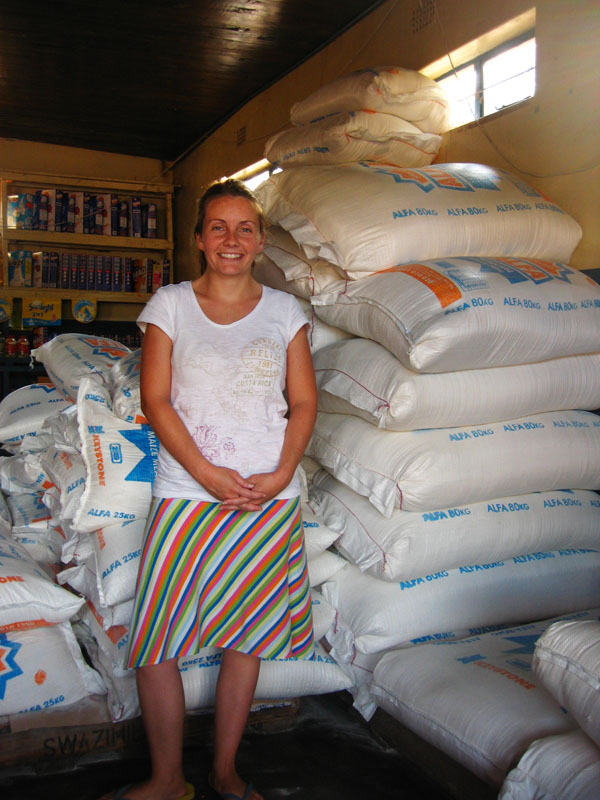
Lora standing with the massive 80kg bags of mielie meal sold at the village store. Most families eat one of these bags every month!
But that’s basically it for food in South Africa, well, our portion of South Africa anyway. Though it turns out we don’t appreciate the flavor / texture of a lot of the staple foods, we’ve definitely had our share of interesting experiences with the food here and have found a few that we really enjoy.
If you’re interested, here’s a short list of other meats I’ve eaten since I’ve been here, those not included in the above descriptions: impala, crocodile, kudu, African water buffalo, hippo, zebra, springbok, blesbok, warthog, eland, gemsbok, and wildebeest. As I said, South Africa is a very carnivorous country and nearly everything is eaten! They say that giraffe is actually very tasty and we hear that guinea fowl is delicious. We’ll surely have a few more interesting food experiences here before we leave.

